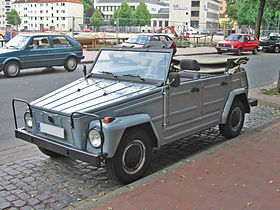Volkswagen type 181
| Volkswagen Type 181/182 | |
|---|---|
 |
|
| Overview | |
| Manufacturer | Volkswagen |
| Also called | Volkswagen Type 181 (LHD) Volkswagen Type 182 (RHD) Sold as: Volkswagen Thing (United States) Volkswagen Camat (Indonesia) Volkswagen Safari (Mexico) Volkswagen Trekker (UK) |
| Production | 1968–83 (1980 for civilian use) 90,883 built (70,519 in West Germany, 20,364 in Mexico) |
| Assembly |
Wolfsburg, West Germany (1968–74) Hannover, West Germany (1974–83) Puebla, Mexico (1970–80) Jakarta, Indonesia (1973–80) |
| Body and chassis | |
| Class | Military vehicle |
| Body style | 4-door Cabriolet |
| Layout | Rear engined |
| Powertrain | |
| Engine | 1.5 or 1.6l H4 |
| Transmission | 4-speed manual |
| Dimensions | |
| Wheelbase | 2,400 mm (94.5 in) |
| Length | 3,780 mm (148.8 in) |
| Width | 1,640 mm (64.6 in) |
| Height | 1,620 mm (63.8 in) |
| Curb weight | 910 kg (2,006 lb) |
| Chronology | |
| Predecessor | Volkswagen Kübelwagen |
| Successor | Volkswagen Iltis |
The Volkswagen Type 181 is a two-wheel drive, four-door, convertible, manufactured and marketed by Volkswagen from 1968 to 1983. Originally developed for the West German Army, the Type 181 was also sold to the public, as the Kurierwagen in West Germany, the Trekker (RHD Type 182) in the United Kingdom, the Thing in the United States (1973–74), the Safari in Mexico and South America, and Pescaccia in Italy. Civilian sales ended after model year 1980.
Manufactured in Wolfsburg, West Germany (1968–74), Hannover, West Germany (1974–83), Puebla, Mexico (1970–80), and Jakarta, Indonesia (1973–80), the Type 181 shared its mechanicals with Volkswagen's Type 1 (Beetle) and the pre-1968 Volkswagen Microbus, its floor pan with the Type 1 Karmann Ghia, and its concept with the company's Kübelwagen, which had been used by the German military during World War II.
During the 1960s, several European governments began cooperating on development of a vehicle known as the Europa Jeep, a lightweight, amphibious four-wheel drive vehicle that could be mass-produced for use by various national military and government groups. Development of the vehicle proved time-consuming, however, and the West German government was in need of a limited number of light, inexpensive, durable transport vehicles that could fulfill their basic needs while the Europa Jeep was being developed and put into production.
Although Volkswagen had been approached during the 1950s about building such a vehicle, and had subsequently passed on the proposition, the then-current management of the company saw the project as having some amount of potential as a consumer vehicle; Mexican customers were asking for something that could handle rural roads better than the Type 1, which was a large seller in Mexico at the time, and the popularity of VW-based dune buggies within the U.S. made executives think that a durable, fun, off-road-capable vehicle would become attractive to many buyers. VW could keep cost to a minimum and thus maximize profitability by using existing parts.
...
Wikipedia
